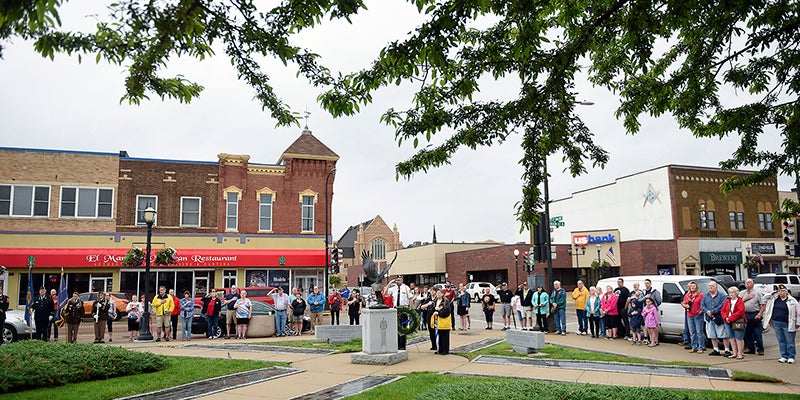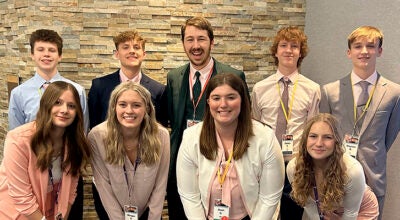Society news
Published 10:15 am Sunday, June 4, 2017
Duplicate Bridge
Tuesday, May 16, seven and a half tables played at the Mower County Senior Center. First place, Barb Engebretson and Orrin Roisen; second place, Loren Cleland and Dave Rin; third place, Gail and Ray Schmidt; fourth place, Gene Muchow and Ron Peters; fifth place,Vandy Newman and Bud Higgins; sixth place, Barb Rofshus and Lorraine Quinlivan; seventh place, Judy Bungum and Dave Solomonson.
Wednesday, May 17, six and a half tables played at the Mower County Senior Center. North/South: First place, Barb Engebretson and Gene Muchow; second place, Stan Schultz and Dave Funkhauser; third place, Loren Cleland and Bud Higgins; East/West: First place, Dave Ring and Orrin Roisen; second place, Gail and Ray Schmidt; third place, Bonnie Fritz and Romelle Enderson
Players were from Austin, Albert Lea, Adams and Rose Creek. All bridge players are encouraged to join us at 12:30 p.m. on Tuesdays and noon on Wednesdays.
Brownsdale Study Club
The Brownsdale Study Club met at the home of Ida Foster on May 17. President Joyce Juhnke called the meeting to order with all members reading the collect.
The secretary-treasure’s reports were read and approved. Nine members answered roll call by sharing something they remembered about May Baskets. There was no old business. New business was the opening of the new Hy-Vee store in Austin on May. 16.
It is a large building with beautiful decor and many new products. The managers hand you a map to help you on your way to find all the goodies and groceries.
They we sang happy birthday to Fern Paschke for her 80th birthday. Fern will also be our hostess for our June meeting.
A motion was made by Beryl Sprung and seconded by Leone Peters to adjourn the meeting.
There was no outside reading.
The main topic was given by Mary Gallaher on the “Return of the Trumpeter Swans.”
The trumpeter swans, the world’s largest waterfowl species, almost disappeared from our landscape during the 1800s. They are a large bird that weighs up to 35 pounds and stand ups to four feet tall with a wingspan of nearly eight feet. It’s trumpeting calls can be heard over a half mile away. The loud call is made by a loop of the windpipe inside the breastbone.
Adults have snow-white plumage with black legs and a black bill. Juveniles have pearly-gray plumage with black legs and pinkish bills in their first. Year. The birds can live for more than 25 years. However, in those early years the birds were not protected so European fur trappers and settlers hunted swans for their meat, the swan skis and swan’s down. Fur buyers shipped swan skins to Europe to cut up and sell for ladies powder puffs. The birds long wing feathers made popular quills.
John Audubon preferred trumpeter swan quills for his detailed drawings.
From 1853 through the 1870s, the Hudson Bay Company purchased 17,671 swanskins. However, by 1877, the swan population was reduced and only 122 swan skins were sold. By 1932 only 69 trumpeter swans survived in the continental United States, mainly in Montana. Hennepin Parks was concerned and began to reintroduce the swans to Minnesota. They, along with the DNR, established a flock with 15 breeding pairs. They also launched funds from donations received from the Nongame Wildlife Program to restore the swans.
They needed to perfect techniques for collecting, transporting and hatching swan eggs and then have someone who could care for the cygnets in the hatching and rearing process.
Steve Kittelson, an ace biologist, finally worked out details for the project. They would fly to Minto Flats — the swan’s nearest nesting area — in Alaska in 1986 and collect eggs on wetlands when the embryos were three or four weeks old and strong enough to endure jostling on the flight back.
They collected only two eggs from each nest and in 24 hours had 50 swan eggs. The biologist candled each egg to be sure the embryo was alive.
For carrying the eggs safely, they adapted a suitcase with foam liners and cavities for 12 eggs. They allowed air circulation from a fan in the end of the suitcase. They four old-fashioned hot water bottles would be laid over the eggs to maintain temperatures about 100 degrees.
The tucked the suitcases in the plane’s overhead bins.
The project worked. Upon the arrival at Carlos Avery the eggs were put in pheasant egg incubators. Regularly the eggs were misted and turned. They required 33-34 days in the incubation. As the cygnets neared hatching they kept the eggs close together so they would hear each other’s peeping and not bond to people.
For several weeks they had special food and care. Next they moved outdoors to a pen in a shallow pond. Wire mesh fencing protected them from predators. Later, they were put in separate pens because if they are raised together they will not mate. They also clipped their wing feathers. After 23 months, they were released to their new home near Detroit Lakes, Minnesota.
A survey in 2015 tallied 17,021 swans. That suggests that now 1,700 nesting pairs produce about 5,000 cygnets in a year. The biologist who collected the eggs returned to the winter site on the Mississippi River near Monticello, Minnesota to observe the swans in 1997.
One swan came close enough so he could photograph the bird and the leg band. It was a number from the Minto Flats that showed it was one of the first eggs collected in 1986.
Maybe he recognized the biologist and came close to say thanks.




